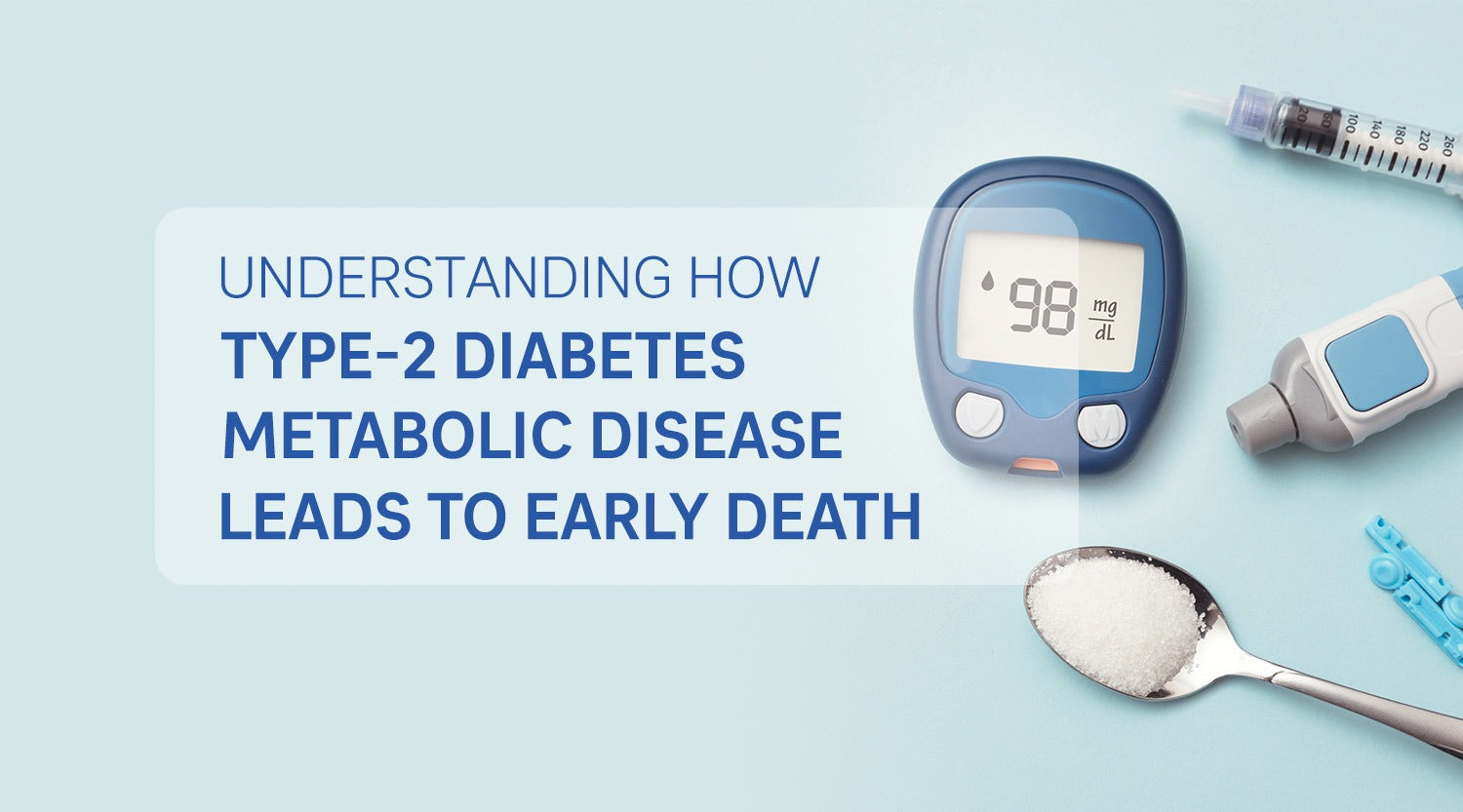
Understanding How Type-2 Diabetes Metabolic Disease Leads to Early Death
In the realm of modern healthcare, one disease silently creeps into millions of lives, leaving a trail of devastation in its wake – Type 2 Diabetes. What begins as a seemingly manageable metabolic disorder can swiftly transform into a harrowing journey towards premature mortality. The insidious nature of Type 2 Diabetes is often overlooked, overshadowed by more immediate health concerns. However, delving into its mechanisms and consequences reveals a stark reality: it stands as the leading cause of early death in contemporary society. This article explores the intricate web of factors contributing to this alarming phenomenon, shedding light on the urgent need for awareness, prevention, and complete management of this metabolic disease.
Life Threatening Complications
At first glance, Type 2 Diabetes may appear benign, often asymptomatic in its early stages. However, beneath this aspect lies a force of physiological imbalances that progressively undermine the body's vital functions. Uncontrolled hyperglycemia wreaks havoc on various organs, paving the way for a myriad of life-threatening complications:
- Cardiovascular Disease: Perhaps the most notorious consequence of Type 2 Diabetes is its profound impact on cardiovascular health. Elevated blood glucose levels contribute to endothelial dysfunction, arterial stiffness, and dyslipidemia, fostering the development of atherosclerosis and significantly increasing the risk of heart attacks, strokes, and peripheral vascular disease.
- Renal Failure: The kidneys, tasked with filtering waste products from the blood, bear a heavy burden in diabetic individuals. Prolonged exposure to high glucose levels damages the delicate renal vasculature and nephrons, culminating in diabetic nephropathy.
- Neuropathy: Diabetes-induced nerve damage, or neuropathy, manifests in various forms, including peripheral neuropathy affecting the extremities, autonomic neuropathy disrupting involuntary bodily functions, and diabetic neuropathic pain. These complications not only diminish the quality of life but also raise the specter of foot ulcers, infections, and lower limb amputations.
- Retinopathy: The eyes act as windows into the systemic repercussions of diabetes, with diabetic retinopathy emerging as a prominent cause of blindness in adulthood. If microvascular abnormalities such as retinal hemorrhages, exudates, and neovascularization are not treated, they might lead to progressive visual loss.
- Infections: Impaired immune function and compromised wound healing render individuals with Type 2 Diabetes particularly susceptible to infections, ranging from recurrent urinary tract infections and skin abscesses to severe bacterial or fungal complications, posing a grave threat to overall health.
- Cancer: Emerging evidence suggests a complex interplay between diabetes and cancer, with Type 2 Diabetes conferring an increased risk for certain malignancies, including pancreatic, liver, colorectal, and breast cancer. Shared risk factors such as obesity, inflammation, and insulin resistance contribute to this ominous association.
Best Practices for Type 2 Diabetes Management
Lifestyle and Dietary Changes for Diabetics
Managing type 2 diabetes calls for mindful lifestyle and diet choices. Here's a list:
- Opt for whole grains: These are lower in sugar and high in fiber, aiding blood sugar control.
- Increase fruits and vegetables: A colorful plate with varied veggies and fruits provides nutrients and helps manage weight.
- Choose healthy fats: Avocados and nuts contain fats that are good for heart health.
- Monitor carbohydrate intake: Keep track of carbs to manage glucose levels.
- Stay hydrated: Water is the best drink to maintain hydration without raising blood sugar.
- Limit alcohol and avoid smoking: Both can worsen diabetes complications.

These changes can significantly impact your overall health and aid in managing your diabetes effectively.
Most Effective Supplements for Blood Sugar Control
- A-Berine
- Alpha-Lipoic Acid (ALA)
- Cinnamon
- Chromium
- Fiber (Psyllium Husk)
The Lethal Combination: Diabetes and Comorbidities
Compounding the risk of Type 2 Diabetes are its intricate interconnections with a constellation of comorbidities, amplifying the risk of premature death exponentially. Obesity, a hallmark feature of the modern diabetes epidemic, fuels a vicious cycle of insulin resistance, adipose tissue inflammation, and dysregulated lipid metabolism, setting the stage for metabolic syndrome, fatty liver disease, and, ultimately, Type 2 Diabetes itself.
Moreover, the nexus between diabetes and mental health disorders cannot be understated. Depression, anxiety, and diabetes distress often coexist in a bidirectional relationship, each exacerbating the other and precipitating detrimental effects on self-care behaviors, glycemic control, and overall prognosis.
The Price of Ignorance: Socioeconomic and Cultural Determinants
While Type 2 Diabetes affects individuals across all strata of society, its burden disproportionately falls upon marginalized populations grappling with socioeconomic disparities, limited access to healthcare resources, and cultural barriers to preventive measures and treatment adherence. Structural inequities in education, income, and healthcare access converge to perpetuate a vicious cycle of health inequality, perpetuating the cycle of premature morbidity and mortality among vulnerable communities.
Regular Monitoring and Health Professional Engagement
Regular monitoring and engaging with health professionals are critical in managing Type 2 Diabetes. Here's how these practices help:
- Consistent Blood Sugar Tracking: Keep a daily log of blood sugar levels. This helps spot trends and adjust treatment promptly.
- Scheduled Health Checkups: Regularly visit your doctor to review your diabetes management plan.
- Access to Professional Advice: Get expert medication, diet, and exercise guidance, which tailors your plan to your needs.
- Early Detection of Complications: Regular health checks can catch issues early, leading to prompt treatment and better outcomes.
- Support System: Health professionals provide support. They motivate you to stick to your management plan.
Shattering the Silence: Strategies for Prevention and Management
Confronting the switch to Type 2 Diabetes demands a multifaceted approach encompassing public health initiatives, policy interventions, and individual empowerment. Education emerges as a potent tool in dispelling myths, fostering lifestyle modifications, and empowering individuals to assume an active role in their health journey.
From a clinical standpoint, early detection and personalized management are paramount in mitigating the progression of diabetes and avoiding its severe complications. Regular screening for diabetes and its comorbidities and comprehensive risk factor modification form the cornerstone of preventive care. Lifestyle interventions encompassing dietary optimization, regular physical activity, stress management, and smoking cessation yield substantial dividends in improving glycemic control and cardiovascular outcomes.
Furthermore, pharmacological therapies targeting hyperglycemia, hypertension, dyslipidemia, and other cardiometabolic risk factors play a pivotal role in preserving vital organ function and enhancing long-term survival. However, pursuing optimal health extends beyond conventional medicine, embracing general modalities such as mindfulness practices, social support networks, and community engagement to foster resilience and enhance overall well-being.
In the battle against Type 2 Diabetes, the stakes are unequivocally high, with the specter of early death casting a long shadow over millions of lives worldwide. Yet, within this dark reality lies a glimmer of hope – a collective resolve to confront this silent killer head-on, armed with knowledge, compassion, and unwavering determination. By fostering a culture of awareness, empowerment, and inclusivity, we can stem the tide of premature mortality and pave the path toward a future where diabetes no longer reigns supreme as the indication of untimely demise.
References
- Care, Diabetes. "Medical care in diabetes 2020." Diabetes Care43 (2020): S135.
https://retinopatiacukrzycowa.pl/wp-content/uploads/2020/01/Microvascular-Complications.pdf
- Emerging Risk Factors Collaboration. "Diabetes mellitus, fasting blood glucose concentration, and risk of vascular disease: a collaborative meta-analysis of 102 prospective studies." The lancet9733 (2010): 2215-2222.
https://www.thelancet.com/journals/lancet/article/PIIS0140673610604849/fulltext
- Boyle, James P., et al. "Projection of the year 2050 burden of diabetes in the US adult population: dynamic modeling of incidence, mortality, and prediabetes prevalence." Population health metrics8 (2010): 1-12.
https://link.springer.com/article/10.1186/1478-7954-8-29
- Einarson, Thomas R., et al. "Prevalence of cardiovascular disease in type 2 diabetes: a systematic literature review of scientific evidence from across the world in 2007–2017." Cardiovascular diabetology17 (2018): 1-19.
https://link.springer.com/article/10.1186/s12933-018-0728-6
- Punthakee, Zubin, Ronald Goldenberg, and Pamela Katz. "Definition, classification, and diagnosis of diabetes, prediabetes, and metabolic syndrome." Canadian journal of diabetes42 (2018): S10-S15.
https://www.canadianjournalofdiabetes.com/article/S1499-2671(17)30813-4/fulltext
Share
